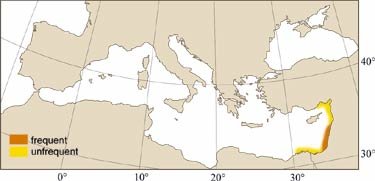
|
Relevant Synonyms
Misidentification
|
|
| photo: S. Gofas / Coll. G. Spada |
|
SHORT
DESCRIPTION
color :
exteriorly white to cream occasionally spotted upon the radial ribs with brown, lunule stained with purple underneath the beaks. Internally white with a cream flush within the pallial line area, ligament stained with violet.
common size :
shell to 50 mm in length. |
DISTINGUISHING CHARACTERISTICS
BIOLOGY / ECOLOGY
habitat :
intertidal and shallow water; muddy gravels and sands. |
|
1st
Mediterranean record
|

|
|
DISTRIBUTION
|
ESTABLISHMENT SUCCESS
speculated reasons for success :
|
|
|
MODE OF
INTRODUCTION |
IMPORTANCE TO
HUMANS |
|
KEY
REFERENCES
|
|
|
 Venus pectinata Linnaeus, 1758
Venus pectinata Linnaeus, 1758